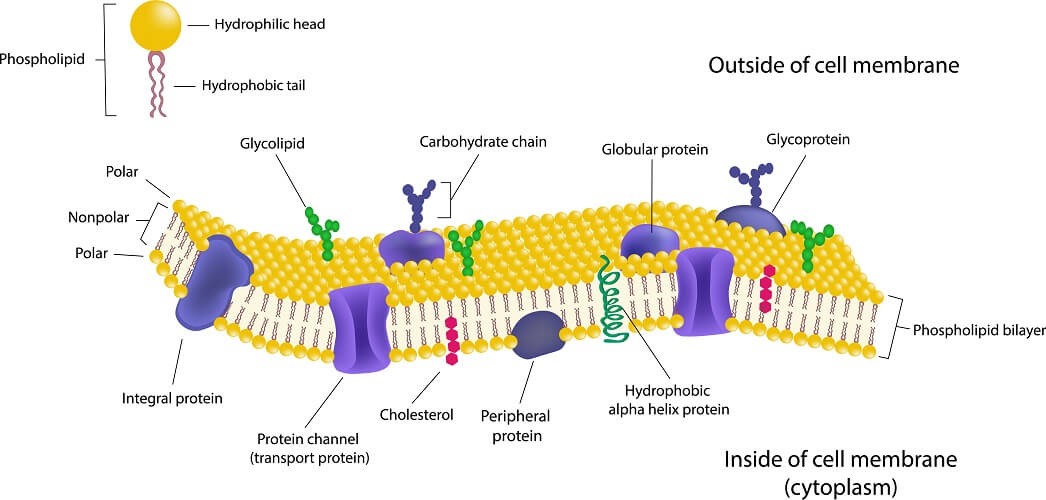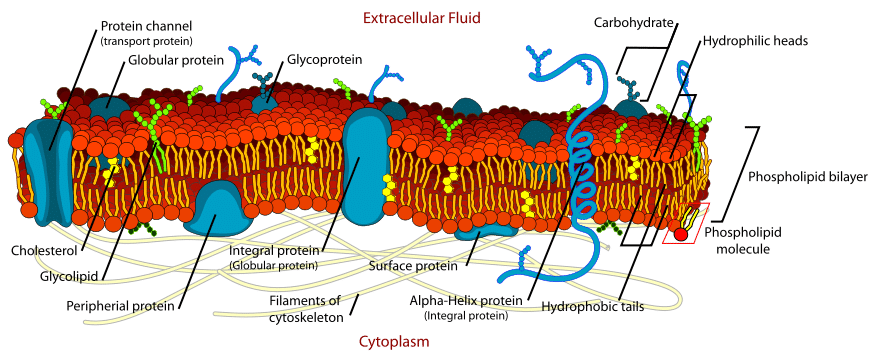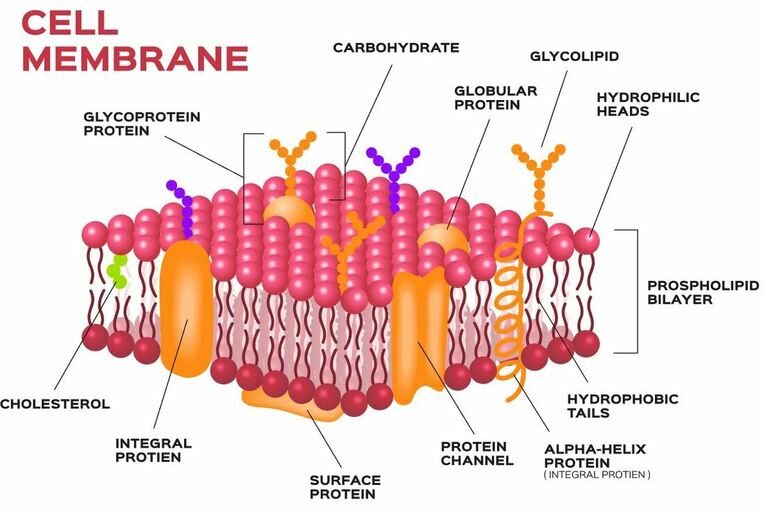Describe the Basic Structure of the Cell Membrane
Phospholipids make up the basic structure of a cell membrane. Each lipid molecule has a hydrophilic phosphorylated head and a hydrophobic fatty acid tail.

Cell Membrane The Definitive Guide Biology Dictionary
Proteins and lipids are the major components of the cell membrane.

. Cytoskeletal elements are usually absent 5. All of the functions for cell expansion growth and replication are carried out in the. The cell membrane is made of a double layer of_____ and _____.
Ribosomes are small 4. Describe the basic structure of the cell. It maintains the integrity of a cell and controls passage of materials into and out of the cell.
The cytosol is the material that creates the cytoplasm. Fluid-Mosaic Model of cell membrane It depicts the plasma membrane as an exceedingly thin structure composed of a double layer or bilayer of lipid molecules with prot. No membrane-bound organelles and no nucleus 2.
Cell membranes are not solid structures. The cell membrane or plasma plazma membrane is the outermost component of a cell. 2 pts Previous question Next question.
Double membrane surrounding the nucleus. The cell membrane also called the plasma membrane is common to all living cells and serves as a barrier that controls what enters and leaves a cell. This review article starts with a description of the lipids forming the neuronal membrane and the forces which maintain their cohesion to form the basic structure of the membrane.
1The structure of plasma membrane is explained by fluid mosaic membrane model. The landscape of the membrane is studded with proteins some of which span the membrane. It protects the integrity of the cell along with supporting the cell and helping to maintain the cells shape.
The cell membrane has many functions. First it defines a cell by enclosing cellular contents within the cell. Cell membranes are at their most basic composed of a phospholipid bilayer with some surface proteins embedded around the surface.
It is helpful to think of the cell membrane as a boundary that forms between the cells internal and external environment. In the case of the plasma membrane these compartments are the inside and the outside of the cell. All materials within a cell must have access to the cell membrane the cells boundary for the needed exchange.
A single phospholipid molecule has two different ends. 3 pmts The diagram below shows a cross section of part of a cell membrane. Describe the nuclear envelope.
Contain distinct organelles surrounded by membrane 2. Plasma membranes contain phospholipids cholesterol proteins and carbohydrates that are arrayed in regular repeating rows to form a highly plastic surface for the cell. The cell membrane is a fluid matrix made of a phospholipid bilayer.
We describe some of the intrinsic biophysical properties of biological bilayers and also to make special mention of the neuronal membrane proteins both peripheral and integral. It is made of phospholipids which have hydrophilic water-loving heads and. Describe the structure of the plasma membranecell membrane -Basic structure according to fluid mosaic model.
Organelle and where they are 19 terms. Structure of the Cell Membrane. The basic function of the cell membrane is to protect the cell from its surroundings.
The plasma membrane is composed of a bilayer of phospholipids with their hydrophobic fatty acid tails in contact with each other. The cell membrane is selectively permeable to ions and organic moleculecules and controls the movement of substances in and out of cells. Controls the movement of substances into and out of the cell.
Describe the basic structure of the cell membrane. Singular circular chromosome 3. The flexibility of the cell membrane also enables the cell to immerse in food and other material from its external environment.
It maintains the integrity of a cell and controls passage of materials into and out of the cell. However cells may have. Substances outside the cell are called extracellular substances and those inside the cell are called intracellular sub-stances.
Such processes are known as endocytosis. The head end contains a phosphate group and is hydrophilic. The proteins float in the lipid bilayer forming a changing mosaic pattern.
A phospholipid is broken into two parts the heads and tails. Chromosomes are linear 46 in human body 3. The exact mix or ratio of proteins and lipids can vary depending on the function of a specific cell.
Cell membrane cellular organelles cytoplasm and nucleus. Ahlukileoi and 8 more users found this answer helpful. This means that it likes or is attracted to water molecules.
Describe two primary functions of the cell membrane. The cell membrane is flexible and is made up of organic molecules called lipids and proteins. It consists mainly of water salts and proteins.
The cytoplasm is a thick solution that fills each cell and is enclosed by the cell membrane. Structure of the Cell Membrane. Basic Structure of a Cell 50 terms.
The fundamental structure of the membrane is the phospholipid bilayer which forms a stable barrier between two aqueous compartments. The heads are hydrophilic water-loving and point to the outside and inside regions making the inner and outer wall while the tails are hydrophobic water-hating and face each other to make the inside of the membrane. Cell membranes all have the same basic structure composed of two facing layers of lipids.
This cell structure is a semipermeable membrane found outside the cytoplasm or gel-like interior of the cell. The cell membrane separates the material outside the cell extracellular from the material inside the cell intracellular. A head and a tail.
The cell membrane is a double layer of phospholipid. T he cell membrane separates the material outside the cell extracellular from the material inside the cell intracellular. The cell membrane structure is a lipid bilayer with proteins carbohydrates and other lipids embedded within.
The cell membrane is a multifaceted membrane that envelopes a cells cytoplasm. The hydrophobic parts of the molecules on the bilayer face each other whereas the hydrophilic parts form the inner and outer surfaces of the cell membrane. Depicts the plasma membrane as exceedingly thin 7- 10nm flexible structure composed of a double layer or bilayer of lipid molecules with protein molecules plugged into it.
The tail end is made up of two strings of hydrogen and carbon atoms called fatty acid chains. Tough cell wall Eukaryotes 1. The modern understanding of the plasma membrane is referred to as the fluid mosaic model.
The cell membrane encloses the cytoplasm and forms the boundary between material inside the cell and material outside it. The cell membrane has two rows of phospholipids.

The Cell Membrane Structure Phospholipids Teachmephysiology

Structure Of The Cell Membrane Biology For Majors I

Histology Molecular Structure Of The Cell Membrane Cell Function Structure Science Online
No comments for "Describe the Basic Structure of the Cell Membrane"
Post a Comment